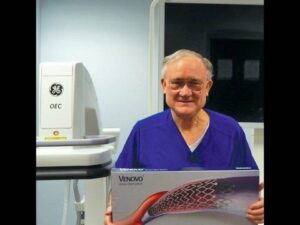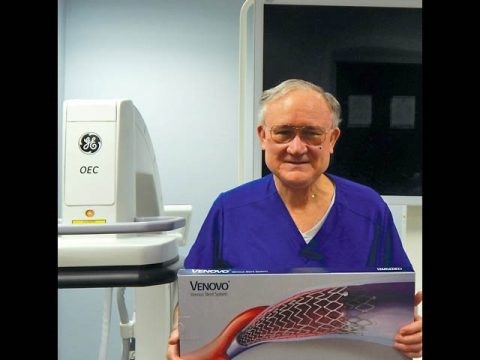VeinCare Centers of Tennessee is one of the first clinics in the United States to implant the new BD Venovo stent in obstructed pelvic veins.
The Venovo stent is the first stent designed specifically for use in treating obstruction of veins to be approved by the Food and Drug Administration (FDA)
The Venovo stent is a flexible metallic stent which resembles a Chinese finger-trap designed to open blocked veins of the pelvis and upper thigh in order to allow blood to return to the heart.
“We have used stents to treat obstruction of these veins for nearly 25 years, but, finally, we have a stent specifically engineered for use in these veins,” Stephen F. Daugherty, MD, medical director of VeinCare Centers of Tennessee in Clarksville.
Compression or obstruction of veins in the pelvis may cause pain or swelling of the lower extremities, chronic pelvic pain, deep pelvic pain with intercourse or low back pain. Dr. Daugherty said he began to notice 15 years ago that some women who had leg pain or swelling due to pelvic (iliac) vein obstruction also experienced severe pelvic pain and deep pelvic pain with intercourse.

In 2015, he published in the Journal of Vascular Surgery: Venous and Lymphatic Disorders the first report of a series of patients whose pelvic symptoms improved or resolved after stenting the obstructed iliac veins. Other centers have since reported similar findings.
Most of the patients have compression of the iliac vein between the overlying iliac artery and the back bone. This syndrome often is called May-Thurner Syndrome, but obstruction may also be due to scarring from old clotting in the iliac veins (deep vein thrombosis).
“There are more patients with May-Thurner compression or scarring from old clotting than we realized in the past,” Dr. Daugherty said.
He said imaging with CT or MR scans or routine ultrasound often miss the lesions due to limitations of the techniques or interpretation. Diagnosis of the problem requires a combination of clinical awareness of the symptoms that may be due to obstruction and special pelvic venous ultrasound imaging techniques.
Final diagnosis and treatment require venography with injection of a dye into the veins to be followed with X-ray and Intravascular Ultrasound (IVUS), which is ultrasound imaging inside the veins with a tiny catheter.
Dr. Daugherty said these techniques are available in the VeinCare Centers of Tennessee office laboratory in Clarksville. VTN
READ MORE: TennesseeVeinCare.com




